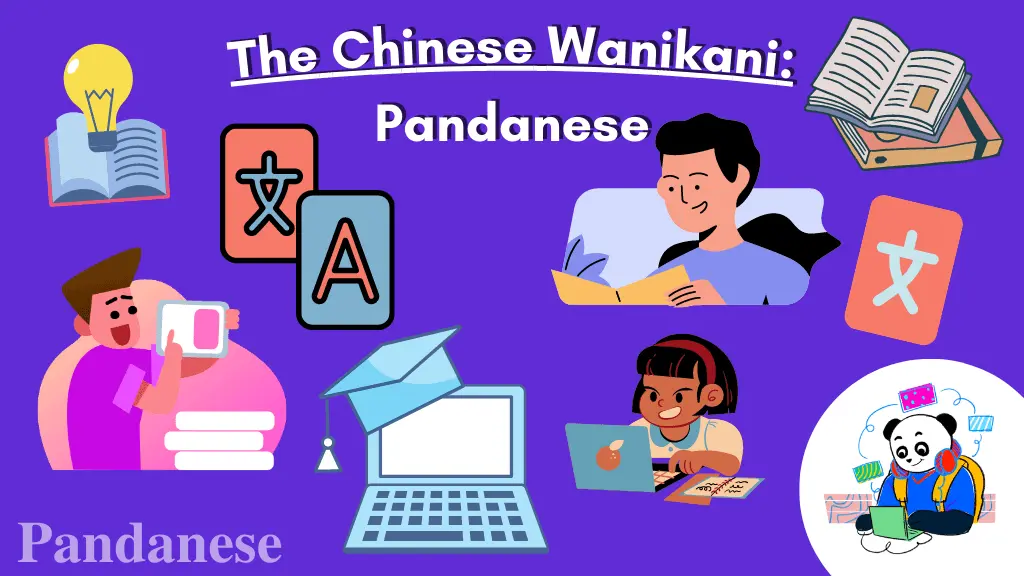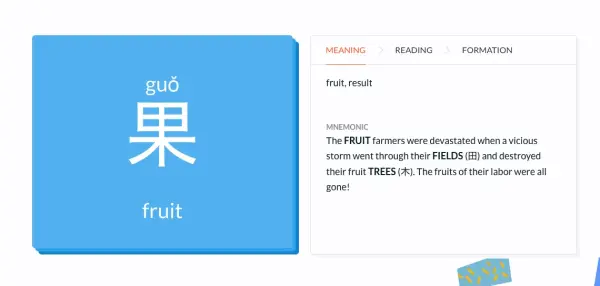
Pandanese—The Wanikani of Chinese Mandarin
Any one learning Japanese must study kanji if they want to master the language. But why?
Without kanji, it's nearly impossible to understand the meaning of a sentence. Kanji gives meaning and context to Japanese words and breaks up sentences, helping you read Japanese quicker and easier. In short, kanji is essential for obtaining Japanese literacy.
So, what's the best way to learn kanji?
With traditional approaches, a university student might learn approximately 1000 kanji in four years. However, there's a more modern and super effective way to help you remember up to 2000 kanji in just one or two years. That is WaniKani!
In this article, you'll learn everything about WaniKani and how it can help you ace your kanji study.
What is WaniKani?
WaniKani is a web-based learning application specifically designed for kanji study. Using scientifically proven methods that improve your memory, including Spaced Repetition System (SRS) and mnemonics, WaniKani teaches and uses the most effective and simplest way to learn kanji and vocabulary.

WaniKani is a study tool created by the Tofugu team. If you study Japanese or just have an interest in Japanese culture, you'll probably have come across Tofugu at some point.
Tofugu is one of the biggest and oldest learning platforms for the Japanese language and culture. From its blogs and textbooks to the podcast and learning app, Tofugu always provides original and fun content and is seen as a dedicated ‘teacher' by many Japanese learners.
Is WaniKani for beginners?
Yes! WaniKani's lessons are simple to follow and study. However, Wanikani recommends that you first study the other two written Japanese scripts (hiragana and katakana), because although you can type kanji and vocabulary readings in English, lessons, and information on readings show only hiragana (no romaji, aka English letters).
What you learn in WaniKani
Radicals
Radicals are like the building blocks or sub-elements of kanji. Essentially, every Japanese kanji character is either a single radical or made up of two or more radicals. For example, the kanji for ‘town' is 町, and 町 is made up of two radicals: 田 (rice paddy) and 丁 (street).

Studying radicals can streamline your kanji learning process as you can guess the meaning or reading (sound) of the kanji based on its radicals. More importantly, radicals are often used in mnemonic stories to help you memorize complex kanji better, so mastering all the basic radicals first will be very beneficial.
Kanji
The main purpose of WaniKani is to teach you kanji. You'll be learning most of the Joyo kanji – a list of common kanji approved by the Japanese Ministry of Education. Plus, WaniKani also teaches non-Joyo kanji that are necessary and practical for everyday life. In general, after completing WaniKani's curriculum, you'll have memorized over 2,000 kanji. With that knowledge, you can read Japanese books, newspapers, manga, and websites easily!

Vocabulary
With the help of WaniKani, you'll be able to learn up over 6,000 vocabulary words alongside related kanji. The vocabulary is strongly connected with the radicals and kanji you've learned in the app. This not only helps reinforce and expand the kanji you've studied but also creates a complete and thorough learning experience.

How can WaniKani help you learn kanji more effectively?
WaniKani applies two proven effective learning strategies to design a unique and simple way for Japanese learners to master kanji.
So, how do they work, exactly?
1. Fun mnemonics
Mnemonic techniques have been proven to boost the ability to remember things quicker and longer and are widely used in our daily lives.
Leveraging this, every new radical, kanji, or vocabulary in WaniKani has a mnemonic to help you recall them better. The mnemonics are humorous and descriptive stories, making it easier for you to imagine and ingrain new knowledge into your brain.

How to memorize the kanji 三 with WaniKani's mnemonics
For instance, to memorize the word three in Japanese 三 /san/, WaniKani creates a funny short story like this: three is the number of chances you get with Santa-san (さん). He has a list, and when you get to three “naughty things” lines, that's it. You're on Santa-san's three strikes, and you're out of the list.
2. Strict Spaced Repetition System (SRS)
SRS is an evidence-based learning method that is proven efficient when learning a foreign language's vocabulary. The SRS technique makes sure you review new knowledge right before you're about to forget it, encoding it into long-term memory.
SRS applications use algorithms to space out your reviews, so repetition happens at an optimal timing. SRS is the total opposite of the cramming study approach as research has shown that spacing out your study sessions reduces the probability of forgetting information.
WaniKani employs SRS to build a review timings system for learning kanji. That is, you'll review easy-to-remember radicals, kanji, and vocabulary less frequently than the difficult ones. Review lessons are also customized specifically to your learning history. If you make a mistake with certain kanji several times, for example, you'll see it repeatedly in your next reviews, rather than the ones you get correct.
Plus, WaniKani ‘forbids' you from learning too many new kanji all at once. After you study a certain amount of new radicals/kanji/vocabulary, the app will freeze your learning to give your brain some time to memorize the new information.
Right after your waiting period is over, you'll have a revision/test of learned knowledge before jumping to the next level.
How to study using WaniKani?
There's a total of 60 levels, with difficulty climbing with each. WaniKani names them accordingly:
Level 1 – 10: Pleasant
Level 11 – 20: Painful
Level 21 – 30: Death
Level 31 – 40: Hell
Level 41 – 50: Paradise
Level 51 – 60: Reality
You can sign up for wanikani free to try out the first three levels. When you reach Level 4, you'll need to subscribe to get a premium account.
What do you experience on a level?
At every level, you'll learn new radicals, kanji, and vocabulary through lessons and have to pass WaniKani's SRS reviews to advance to the next level.
Lessons
Each level consists of 3 sets of lessons with around 140 items in total. You'll always start first with radicals, then kanji, and finally vocabulary. This is a logical way to study as radicals make up a kanji, and a kanji can be a part of many different words. During lessons, you'll be presented with the character, mnemonic, meaning, readings, pronunciation, and usage in context.
After every lesson, you'll be tested immediately on what you've just learned. The quiz's structure will be different for radicals, kanji, and vocabulary. With radicals, you'll simply need to memorize their names, but in the case of kanji and vocabulary, you'll need to type the English meaning and also the reading (aka the pronunciation, in hiragana or katakana). For kanji, you'll also need to remember all possible readings: both the on'yomi (readings derived from Chinese) and kun'yomi (readings derived from Japanese origin).
This quiz right after each lesson lets the WaniKani system determine what information is the highest priority for you to review. After finishing the quiz, you'll need to wait for some time before getting to the review session.
Reviews
You may think that reviews start right away after you finish your lessons and quizzes. But no!
Remember the SRS we mentioned in the previous section? WaniKani was designed using SRS research, and the “spaced” in “Spaced Repetition System” means that learners should wait after absorbing a big chunk of knowledge. For example, your first WaniKani review will start 2 hours after you finish a lesson.
Your performance on reviews will decide when you can unlock the next level. The SRS algorithm gives you one of five stages for each radical, kanji, or vocabulary, depending on how well you know each item::
Apprentice
Guru
Master
Enlightened
Burned
To level up, you must reach at least the Guru stage with a certain amount of kanji. In other words, Guru means that you pass!
The highest stage is Burned (as in, ‘knowledge is burned into your mind'). At this stage, the knowledge has become yours, and you no longer will be tested on that item. You can unburn any items, which puts the item way back to the Apprentice stage!
Remember that you really should do reviews as often as possible, or else the items that need reviewing will pile up very quickly, taking you a lot of time to go over them to unlock the next level.
How long does it take to complete WaniKani?
In theory, about a year. If you finish your reviews on time and answer most correctly, it's 100% possible to conquer 60 levels in just over a year, according to WaniKani. Hard work, consistency, and total focus are required to achieve that.
Many WaniKani users say that finishing 60 levels in a year and a half or two years is more common. After all, you're the one in control. Go at your own pace. If you feel overwhelmed, you can always lower the number of lessons, and speed up whenever you want to!
Learning 2000+ kanji will take a long time anyway, so the only thing that should matter is choosing a pace that keeps you engaged until the end.
Does WaniKani have a mobile version?
WaniKani is a web-based application and doesn't have an official mobile version. The Wanikani site works well on a mobile web browser, and you can find a few unofficial third-party apps in the market.
Keep in mind that WaniKani doesn't hold any responsibility for those mobile apps!
Plans and prices
You can use WaniKani for free until you reach Level 4. At that point, you need to get a premium account, so you have three options to subscribe:
Monthly fee: $9
Annual fee: $89 (2 months free)
Lifetime: $299 (one-time charge)
WaniKani community forum
Your learning experience with WaniKani doesn't just stop at studying and reviewing. WaniKani creates a unique community forum where you can discuss, ask, and answer questions about the Japanese language and culture.
The members are extremely friendly and open-minded. It's a great place to meet new friends or get advice and opinions from other learners on all things Japanese.
Summary: WaniKani's pros and cons
Pros
Fun and intriguing mnemonics
No overwork: SRS helps you pace out reviews to optimize your memory capacity.
Active and helpful community forum
Updated knowledge
Supportive customer service
Cons
Unable to add your own items
Dated interface
No official mobile version
Pandanese: The WaniKani for Chinese language learners
If learning Chinese is also on your wishlist and you're looking for an application that offers the same benefits as WaniKani, Pandanese is just for you.

Pandanese user dashboard
Like WaniKani, Pandanese is a software where you learn hanzi (Chinese characters) and vocabulary efficiently and simply whether online or with the Pandanese App.
As you may know, kanji originated from hanzi as the Japanese didn't have their own writing system, so they borrowed written Chinese, known as hanzi. The term ‘kanji' itself means ‘Han characters.'
But that's not the only similarity between WaniKani and Pandanese. In fact, their core scientific techniques are the same too: using SRS and mnemonic stories to help learners memorize Chinese characters better.
Let's look at these main features of Pandanese, and you'll see for yourself!
1. Study from easy to difficult
Language experts have handcrafted Pandanese's curriculum to make sure building your vocabulary is a solid yet gentle progression. You can listen to the Hanzi pronunciation, type in pinyin, and know the context for each character. Pandanese is perfect for any learning style.

You'll also start with the simplest component of a Chinese word: radicals. Then you'll learn the character and vocabulary built on them.
2. Spaced Repetition System (SRS)
Pandanese uses the SRS algorithm to prompt you to review items at specific times and amounts to maximize your retention.
3. Mnemonics
Everything you learn in Pandanese goes with a mnemonic device that has been proven to help you remember.

Pandanese's Chinese characters learn function with mnemonics.
What are you waiting for? Start your Chinese wanikani with Pandanese today! Sign up now to learn Chinese and try its exclusive features for free!
The easiest way to learn Chinese & build vocabulary

